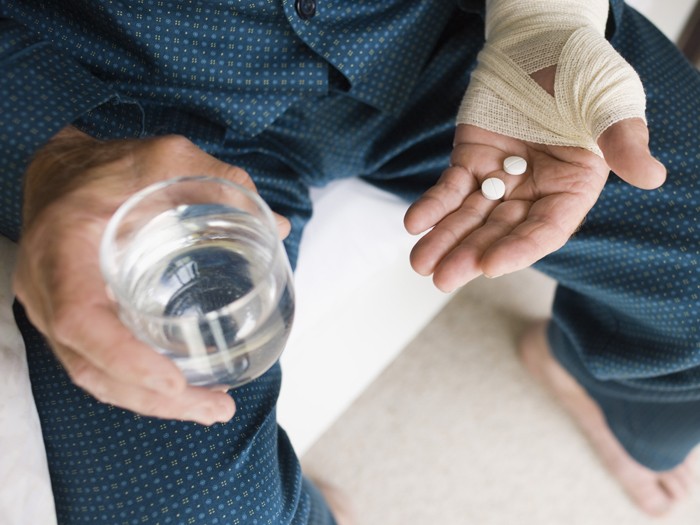Curbing the Opioid Epidemic
Experts: Treat Addiction to Mitigate Opioid Crisis

Stemming the opioid problem in the workers’ comp system should be a multi-faceted approach done in a three-tiered process, says a new study. The key, according to the authors, is ensuring providers are educated about opioid prescribing, identifying those who have recently become addicted, and providing treatment for those affected.
The study, published in the Annual Review of Public Health, says the focus needs to change from addressing the nonmedical use of painkillers to preventing and treating addiction.
“Public health authorities have described, with growing alarm, an unprecedented increase in morbidity and mortality associated with use of opioid pain relievers,” the study begins. “Overprescribing of OPRs has led to a sharp increase in the prevalence of opioid addiction, which in turn has been associated with a rise in overdose deaths and heroin use.”
Opioids and Heroin
Efforts to address the opioid epidemic have, according to some reports, coincided with the increased use of heroin. But the two are not necessary related.
“Not really, especially not the way the media is portraying it,” says Dr. Andrew Kolodny, chief medical officer of the Phoenix House, president of the Physicians for Responsible Opioid Prescribing, and principal author. “It’s becoming dominant narrative — ‘efforts to crack down have had unintended consequences.’ That’s not really accurate.”
Heroin abuse has been increasing “since the beginning of the painkiller problem in 2001,” Kolodny said. “So switching is not happening all of a sudden, it’s been going on from the very beginning.”
Instead, Kolodny says the overprescribing of opioids in the early 2000s created addicts, which likely fueled the rise of heroin abuse. He noted that the age group of people abusing heroin are those under 40 years old.
“Once you’re addicted and you’re young with no medical issues, you can get pills,” he said. “But if you’re badly addicted, it’s hard to get enough pills. … That group winds up on the black market.”
But overprescribing also fosters addiction in older people. The difference, he says, is they are more able to obtain legal painkillers from physicians.
“What’s interesting is the rate of drug overdose deaths is much higher in the 40 plus [age] group that gets pills from doctors, the age group 45 to 50,” he said. “The sharpest increase is in that group and older.”
Physicians, he said, are starting to get the message about opioid abuse and some, at least, are changing their prescribing patterns. However, as the article points out, more physician education is part of the primary prevention step in the process.
“In academia, among leaders in the field, experts, people who read medical journals, it’s very clear. They’ve got the idea,” Kolodny said. “A lot of physicians out there do not read medical journals.”
Addiction
Addiction is defined as “continued use of a drug despite negative consequences.” Injured workers who are physiologically dependent on opioids may become addicts simply by trying to avoid withdrawal symptoms.
“They feel sick when they stop,” Kolodny said. “People think of withdrawal as like having the flu and a panic attack. There is a sense of impending doom. [They feel like] they are going to die. Anyone who’s experienced that will often go to great lengths to avoid going through withdrawal.”
One of the first steps in helping injured workers who are addicted to opioids is identifying them, but that can be difficult.
“With someone who is on opioids that they don’t get from a physician, it’s much easier to spot addiction,” Kolodny said. “People will do all sorts of things to get them — lie, cheat, steal. So the drug-seeking behavior becomes part of the way we identify people with the disease.”
But injured workers who have easy access to large doses of opioids won’t necessarily exhibit those behaviors. “Sometimes they take [the medications] exactly as prescribed and they spend their lives sitting on the sofa,” Kolodny said. “They become depressed and become nonfunctional. What you are seeing is a decline in the quality of their life. If you can attribute that to having been put on opioids even though there is no clear abuse — such as snorting [drugs] or doctor shopping — I’d say that person is addicted. They are continuing to use despite negative consequences.
Treatment
Tertiary prevention strategies involve both therapeutic and rehabilitative measures, according to the article. The goal here is to prevent overdose deaths, medical complications, psycho-social deterioration, transition to injection drug use, and injection-related infectious diseases. Medication as well as psycho-social approaches are recommended.
“Everybody is different,” Kolodny said. “Probably for most people it would be a combination of both. I think at least at the outset there are many people opioid addicted who over time can learn how to manage their addiction by taking one of [the recommended] medications and do pretty well. … But within the first few months or year, they should be getting more than just a prescription, or the likelihood of a good outcome is slimmer.”










